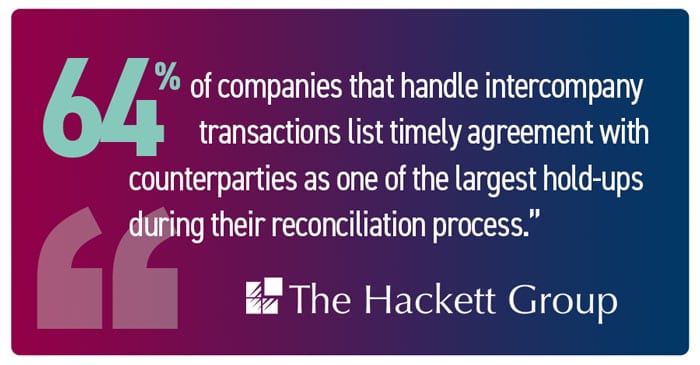(Intercompany) Prevention Is the Best Medicine
Blog post
Share
Intercompany Accounting Is Simple…Isn’t It?
Foundationally, intercompany accounting is the recording of the internal trade of goods or services, and the associated settlement for those goods or services, between a companies’ entities. Think about it as simply moving money from your left pocket to the right pocket of your pants, still your money, but now moved from left to right pocket.
Throughout the month businesses operate as usual, resources are moved between entities, goods are exchanged, and eventually invoices are issued for those activities. Typically, this is all done manually, an email approval from group controller in North America to group controller in the UK for a resource recharge, the entry is booked by both entities independently in their own subledgers, then reconciled and consolidated at the month end. Pretty straightforward right? But who owns the reconciliation, what if there is a dispute between internal counterparts, how can we ensure that the transactions they each book are the same, what if they are in different ERPs?
But Intercompany Is Someone Else’s Problem…Isn’t It?
With multiple internal stakeholders, between tax, treasury, and finance we inherently introduce more complexity into the system. As organizations continue to grow, they also include disparate global entities and manual processes along with an increased volume of activity. This volume is no small number either. According to the United Nations Conference on Trade and Development’s World Investment Report, [1] intercompany transactions account for around 80% of global trade.
The intercompany accounting process has several unique challenges:
- Various internal entities with different ERP systems and subledger ledgers due to mergers and acquisitions
- A lack of process standardization within the organization
- Grey areas with the relationships between the companies involved

These issues create a bottleneck of employees from the receiving entity waiting on the employees of the paying entity to respond before they can finish their work, and a lot of companies have come to accept this as a necessary complication. In fact, according to The Hackett Group, 64% of companies that handle intercompany transactions list timely agreement with counterparties as one of the largest hold-ups during their reconciliation process.[2]
Preventing Long Term Pain with a System of Controls
When analyzing this challenge, it’s important to dive into what makes up intercompany and the controls in place to provide governance, reliability, and accuracy. Intercompany accounting is broken down in to several parts, from initial agreement and execution of the agreement or transaction, to matching and reconciliation parts of the intercompany process. Throughout this process, there are multiple stakeholders across the organization who may be raising a request, approving another area’s request, posting an invoice to our ERP (or system of record), or within a phase of the matching cycle. This upfront validation is called a preventative control in that it’s preventing downstream reconciliation issues by validating that the initial transaction or invoice is raised correctly and both entities have agreed on the amounts. This process exists to ensure all internal financial activities and events between entities are recorded in a timely and accurate manner.
How Preventative Controls Embedded in Automation Can Reduce Risk and Drive Efficiency
With large global transaction volumes, it can become harder for organizations to continue ignoring intercompany pains, hoping they will just go away. Fortunately, with an integrated system of controls and automation, it’s possible to provide visibility into the intercompany process from day one, when the invoice is raised, ensuring timeliness in the cycle and accuracy over the entry posted to your system of record, even reducing additional time down the road when you are matching and reconciling intercompany accounts.
By employing automation technology it’s possible to reduce risk in the process by providing governance, control and visibility around the process. A few ways this can be achieved is through:
Automating ERP integration
- ERP connectors provide an automated, efficient way of interfacing with your system of record, for the purpose of either raising an AR or AP invoice, or for extracting transactions or balances for your period end matching and reconciliation
Automating ERP activity
- As automation occurring in your system of record, ERP Bots can provide a streamlined way of posting to both your AR and AP subledgers from one transactions, further reducing the risk of miscodes and improving the accuracy of invoice postings.
Risk Intelligent Intercompany Transactions
- Using a risk aware workflow to ensure both parties are in sync up front before the invoices are raised reduces the risk that the invoices will mismatch at the period end.
Posting to multiple ERPs from one Intercompany Transaction
- Reduce risk and improve efficiency by creating the both AR and AP intercompany postings from one transaction, centrally created and stored in your system of controls
Collaborative Intercompany workflow
- Encourage collaboration and negotiation among subsidiaries, to ensure accounting codes are input and validated by both parties, before submitting an intercompany invoice to the ERP
Fit for purpose technology
- Keep your ERP as the system of record, maintaining tax rates and a single source of truth for intercompany master data
(Intercompany) Prevention Is the Best Medicine
With a preventative approach to intercompany, an overarching system of controls enabled through automation, it’s possible to reduce risk and improve efficiency in your intercompany accounting processes. The next step will be to evaluate how we can further improve our period end reconciliation and detective controls as part of the intercompany process.

Explore the Full 7-Part Series on Trintech’s System of Controls:
Part 1: Don’t Drown in Transaction Data When Closing – Light a Match and See Clearly
Part 2: Reconciliations: Part of a Global System of Controls to Ensure the Integrity of Your Financial Close
Part 3: Eliminate 95% of Manual Journal Entries and Reduce Risk at the Same Time – Mission Possible
Part 5: How to Reduce Risk and Ensure Control Over Your Intercompany Transactions with Cadency’s Detective Controls
Part 6: How to Excite An Accountant During Close
Part 7: How to Measure the Impact of Your Control Environment Using a Framework for Compliance
[1] United Nations Conference on Trade and Development’s World Investment Report 2013
[2] The Hackett Group: Optimizing the Intercompany Accounting Process 2017
Written by: Michael Uram
Additional Resources:






